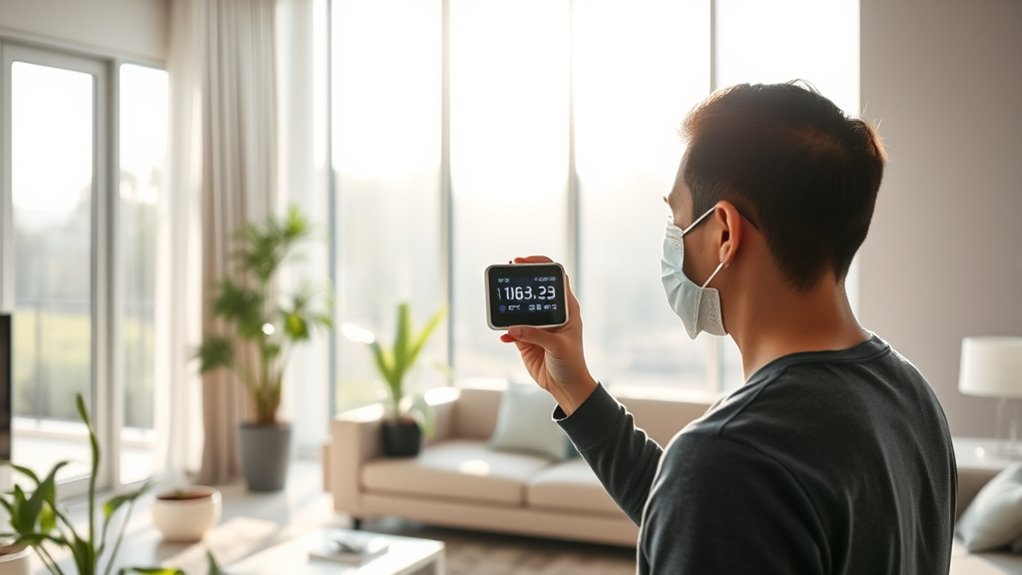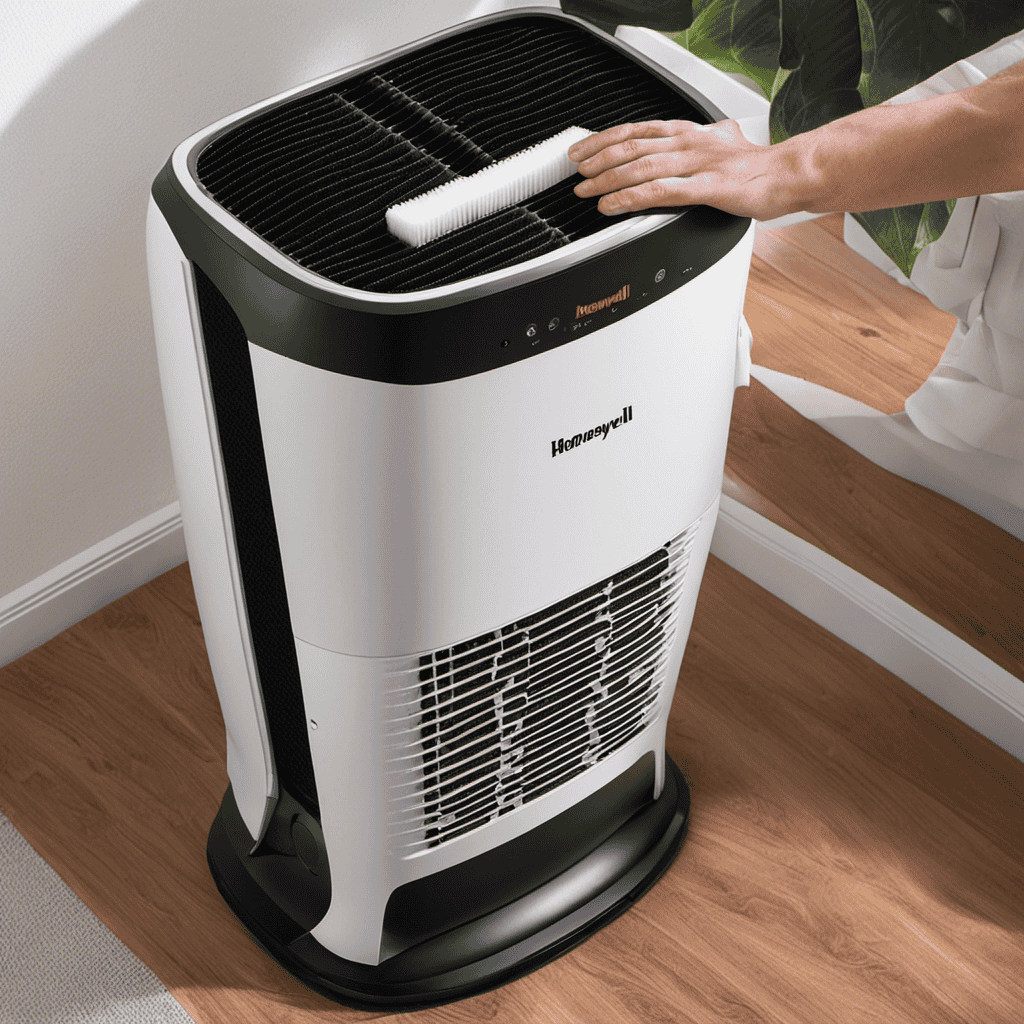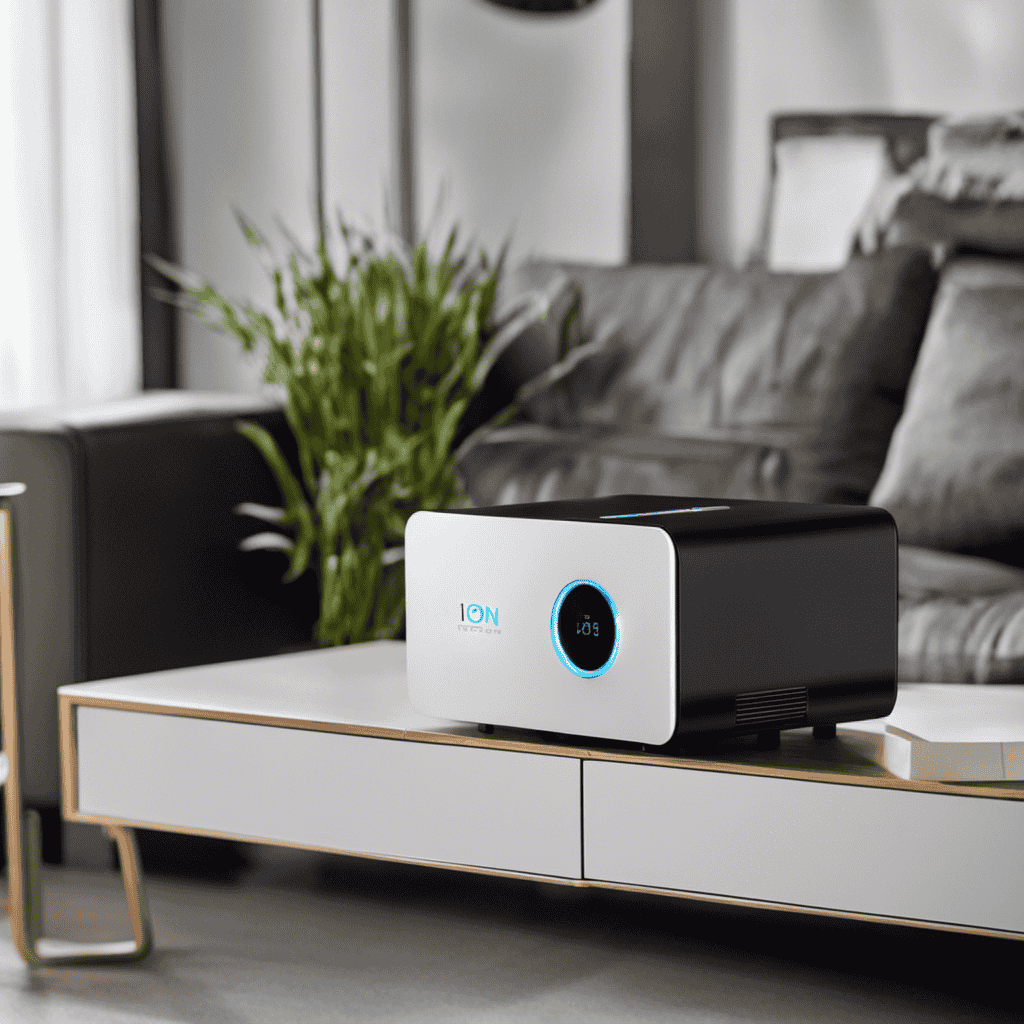If persistent odors, visible mold, or water damage don’t clear up after cleaning, it’s time to get professional help. Also, if you’re experiencing ongoing allergy symptoms despite cleaning and ventilation efforts, or notice excessive dust and allergens, experts can identify hidden sources. Signs like unusual humidity, pest activity, or recent renovations require assessment too. Continuing to ignore these issues can worsen health risks and lead to costly repairs—learn more to protect your air quality.
Key Takeaways
- Persistent odors, dust, or allergy symptoms despite regular cleaning indicate underlying ventilation or hidden source issues.
- Visible mold, water stains, or structural damage signal health risks requiring professional inspection and remediation.
- Ongoing chemical smells, pest signs, or renovation fumes suggest VOC buildup or pest infestations needing expert assessment.
- Uncontrolled humidity or water damage, causing musty odors or condensation, warrant professional intervention to prevent mold growth.
- DIY cleaning efforts fail to improve air quality or leave hazards, highlighting the need for professional evaluation and targeted solutions.
Persistent Unexplained Odors

Persistent unexplained odors can quickly become a source of frustration, especially when you can’t identify or eliminate the smell. To tackle this, consider the effectiveness of your air purifier. A quality air purifier can help remove odors and improve overall air quality, but it’s only part of the solution. Regular HVAC system maintenance is equally important; dust, mold, or debris buildup can cause persistent smells. Ensure filters are changed regularly, and have your system inspected to prevent odor-causing issues. Sometimes, odors stem from hidden sources that a simple air purifier can’t address. Combining improved air purifier effectiveness with proactive HVAC upkeep gives you a better chance of eliminating those stubborn, unexplained odors and breathing easier in your indoor environment. Understanding indoor air quality can help you identify potential sources of odors and improve your home’s air health. Additionally, paying attention to air circulation can significantly reduce odor buildup by promoting fresh airflow throughout your space. Improving ventilation systems is also essential in maintaining a fresh indoor atmosphere, especially in areas prone to moisture or stagnation. Regularly checking for hidden sources of contamination, such as leaks or mold, is also crucial in maintaining a healthy indoor environment. Being aware of the role of indoor air quality testing can further assist in pinpointing concealed issues contributing to persistent odors.
Chronic Respiratory Symptoms
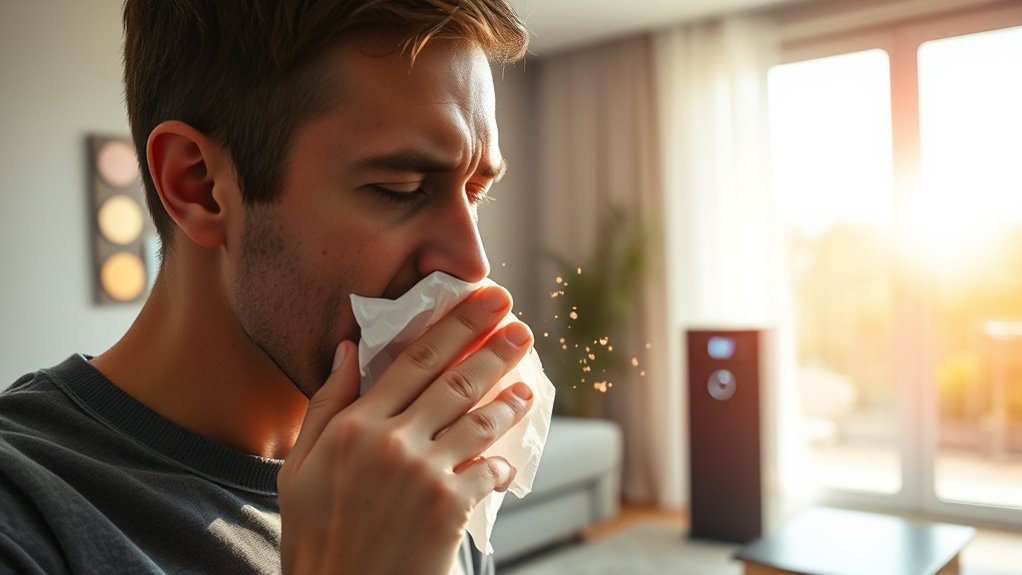
Have you noticed ongoing respiratory issues like coughing, wheezing, or shortness of breath despite trying to improve your indoor environment? Persistent symptoms can indicate poor air quality caused by factors like inadequate ventilation or chemical emissions from household products. If symptoms last long or worsen, it’s time to contemplate professional help. Recognizing indoor air quality issues is essential for timely intervention, especially considering how data privacy challenges can impact the management and monitoring of indoor environments. Being aware of Textile Line patterns and their influence on indoor air quality can also be beneficial.
Visible Mold Growth or Water Damage
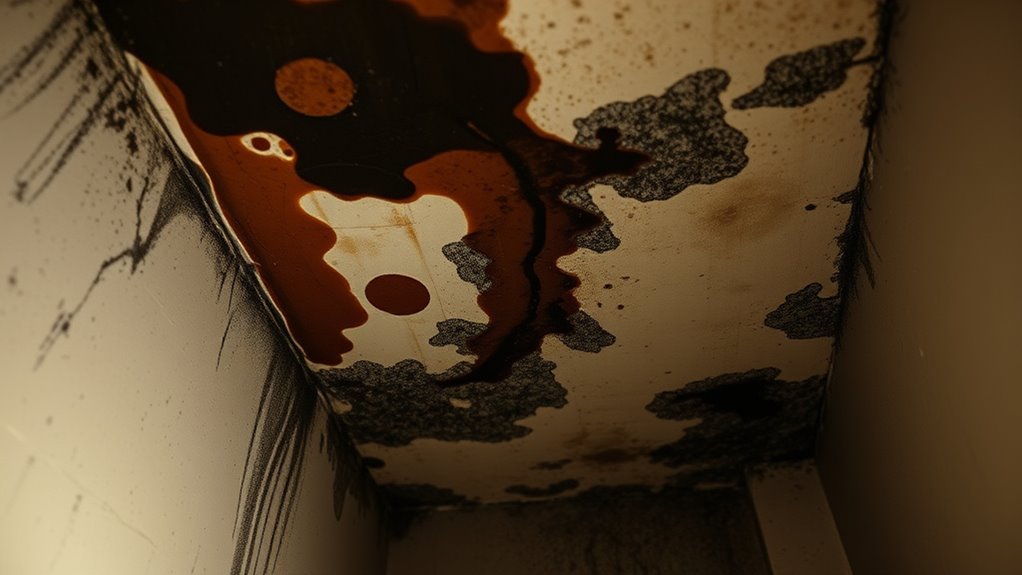
If you notice visible mold or water stains, it’s a clear sign of potential health risks and structural issues. Ignoring these signs can lead to worsened health problems and costly repairs down the line. Addressing water damage early helps protect your home and your well-being. Recognizing the importance of secure payment processing can also prevent financial setbacks if your property sustains damage that impacts your business operations. Timely intervention can also mitigate long-term health effects associated with mold exposure. Utilizing advanced detection technology can improve early identification and remediation efforts, making the process more efficient and effective. Being aware of indoor air quality can guide you in taking appropriate steps to maintain a healthy environment.
Health Risks Evident
Visible mold growth or water damage in your indoor environment signals immediate health risks. Mold spores can trigger allergies, asthma attacks, and respiratory issues, especially if you have indoor plants that can harbor mold or trap moisture. Water damage can lead to the growth of bacteria and other harmful microorganisms, worsening air quality. If you notice these issues, it’s crucial to assess your air purifier maintenance routine—dirty filters won’t effectively remove contaminants. Neglecting visible mold or water damage can worsen health problems over time, particularly for vulnerable individuals. Addressing these signs promptly with professional help ensures proper cleanup and prevents ongoing exposure. Additionally, understanding indoor air quality factors can help you take proactive measures to maintain a healthier environment. Utilizing advanced diagnostic tools can improve the accuracy of identifying hidden problems that may not be immediately visible. Regular inspections and mold remediation are essential steps in safeguarding your indoor air quality and health. Recognizing hidden microbial growth is crucial because it can contribute to ongoing health issues without obvious signs. Protect your health by taking these indicators seriously and acting quickly to improve your indoor air quality.
Structural Damage Indicators
Detecting signs of structural damage, such as visible mold growth or water stains, often indicates underlying issues with moisture intrusion. If you notice foundation cracks or water marks on walls and ceilings, it’s a clear sign that moisture is compromising your home’s integrity. These issues can lead to structural shifts, weakening the building’s framework over time. Mold growth visible on walls or ceilings isn’t just a surface problem—it signals ongoing moisture problems that could impact indoor air quality. Addressing these indicators promptly is essential, as ignoring them can cause more extensive damage and health risks. If you see foundation cracks or signs of water damage, it’s time to consult a professional who can assess the extent of the damage and recommend necessary repairs. Additionally, air quality concerns are often a consequence of unresolved moisture issues, underscoring the importance of moisture management. Implementing proper ventilation strategies can significantly reduce indoor humidity and prevent future damage. Regular inspections for structural damage indicators can help catch problems early before they escalate.
Excessive Dust or Allergens
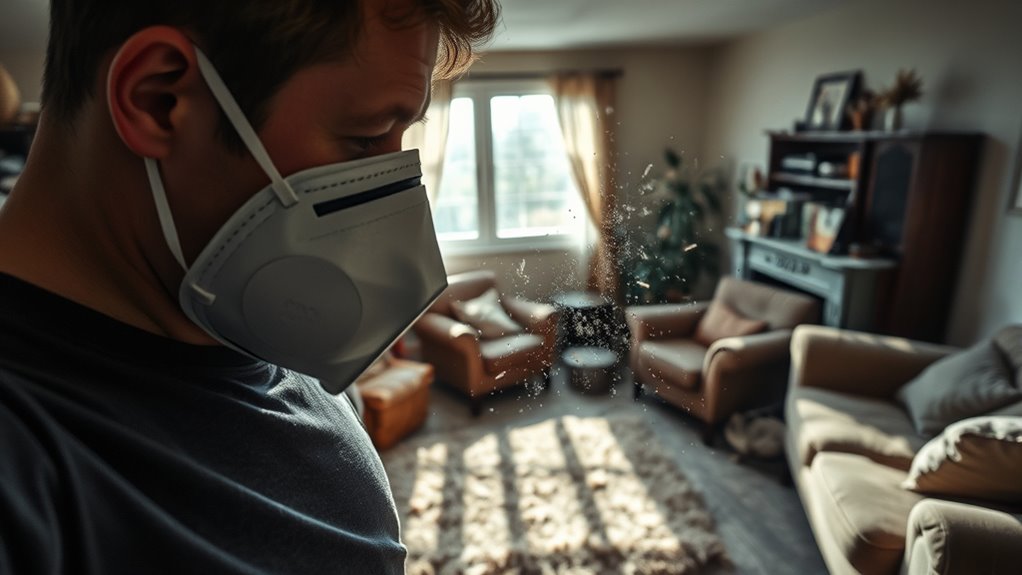
If you notice dust piling up quickly or find yourself sneezing or coughing more often, allergens might be lingering in your home. Unsuccessful cleaning efforts can also leave these particles behind, making the problem worse. Addressing persistent dust and allergens is key to improving your indoor air quality. Using an appropriate air purifier with HEPA filters can effectively remove these particles from the air. Regular maintenance and understanding filter change patterns can help you recognize when to seek professional assistance for deeper air quality issues. Additionally, monitoring air quality indicators can provide insight into ongoing problems that may require expert evaluation.
Persistent Dust Accumulation
Persistent dust accumulation can quickly become a frustrating challenge in maintaining good indoor air quality. You might notice dust settling on surfaces despite regular cleaning. To improve your air purifier’s effectiveness, verify it has a HEPA filter suited for your space and run it continuously. Regular DIY cleaning tips, like dusting with a damp cloth and vacuuming carpets with a HEPA filter vacuum, can cut down dust levels. Decluttering surfaces reduces dust collection points and helps your efforts. Also, consider replacing HVAC filters every 1-3 months to prevent dust buildup in your system. If dust persists despite these efforts, it could indicate underlying issues, and consulting a professional can help identify hidden sources or ventilation problems affecting your indoor air quality. Incorporating shower best practices can also reduce humidity and mold growth that contribute to poor air quality indoors. Additionally, understanding how AI-powered data analysis can identify unseen sources of indoor pollutants may help address persistent dust issues more effectively. Creating proper ventilation systems and ensuring regular maintenance can further improve indoor air quality by reducing airborne contaminants.
Unexplained Allergic Reactions
Despite regular cleaning and dust control efforts, some indoor environments still trigger unexplained allergic reactions. You might notice persistent sneezing, itchy eyes, or coughing even after thorough cleaning. This could be due to allergens hidden in the air that aren’t easily removed. Air purifier effectiveness varies, especially if filters need replacement or the unit isn’t appropriately sized for your space. Additionally, ventilation system maintenance is vital; a poorly maintained system can circulate dust, mold spores, and other irritants. If you continue to experience allergic symptoms despite cleaning, it’s a sign you should seek professional help. Experts can assess your indoor air quality, recommend high-efficiency air purifiers, and ensure your ventilation system is functioning properly to reduce allergens and improve your indoor environment.
Ineffective Cleaning Methods
Ineffective cleaning methods can leave behind excess dust and allergens, making allergy symptoms worse despite your efforts. DIY cleaning may seem sufficient, but if you use improper techniques or skip key steps, dust and allergens can settle deeper into surfaces. Relying heavily on chemical use without proper ventilation can also worsen indoor air quality, as some cleaning products release volatile organic compounds (VOCs). Overusing harsh chemicals can irritate your respiratory system and leave residues that trap more dust. To avoid this, use gentle, allergen-reducing cleaners and ensure thorough dust removal from all surfaces. Remember, ineffective cleaning may give you a false sense of cleanliness, but it often fails to eliminate the root causes of indoor allergens, highlighting the need for professional assessment and targeted cleaning strategies.
Unusual Humidity or Moisture Levels
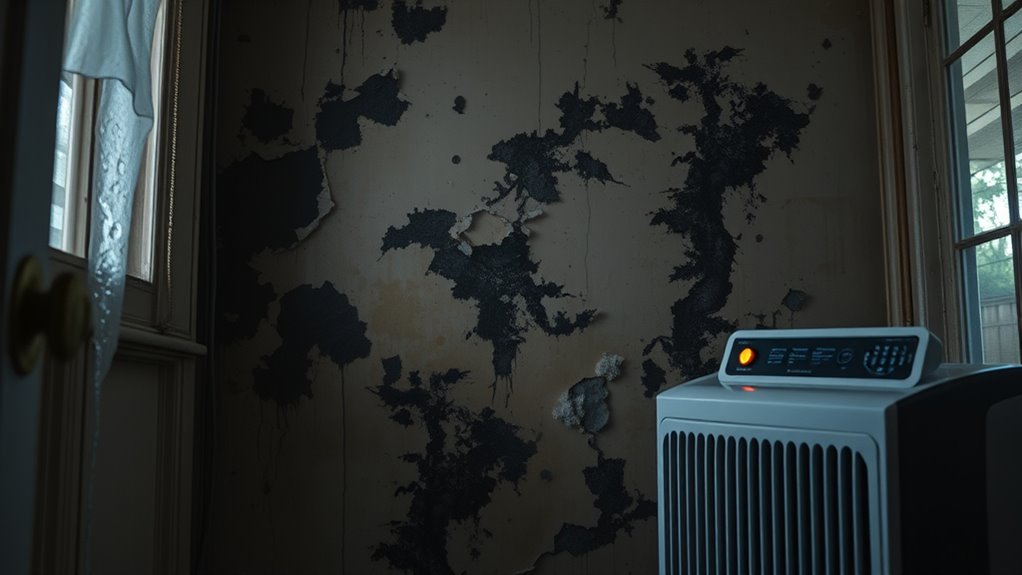
Unusual humidity or moisture levels can considerably impact your indoor air quality, making your home uncomfortable and potentially causing health issues. Excess moisture promotes mold growth, aggravates allergies, and can damage your belongings. Too little humidity causes dry skin, respiratory irritation, and static electricity. You might notice:
Unusual humidity levels can harm your health and damage your home.
- Musty odors lingering in your home
- Condensation on windows and walls
- Indoor plants wilting or browning
Your HVAC system plays a essential role in regulating humidity, but if it’s not functioning properly, moisture problems can persist. Adjusting humidity levels with a dehumidifier or humidifier can help, but persistent issues often require professional assessment. Addressing these fluctuations promptly ensures a healthier, more comfortable living environment.
Signs of Pest Infestation

Have you noticed tiny holes in your walls or gnaw marks on furniture? These are clear signs of pest infestation. You might also spot rodent droppings around your home, especially in hidden corners or behind appliances. If you see these signs, it’s time to contemplate pest control measures. Ignoring these issues can worsen air quality and cause health problems. Below is a quick overview of common pest signs:
| Pest Sign | What to Look For |
|---|---|
| Rodent droppings | Small, dark pellets near food or corners |
| Gnaw marks | Chewed wood, wires, or furniture |
| Unusual noises | Scratching or scurrying sounds |
Act promptly to protect your indoor air quality and home environment.
Recent Renovations or New Furniture
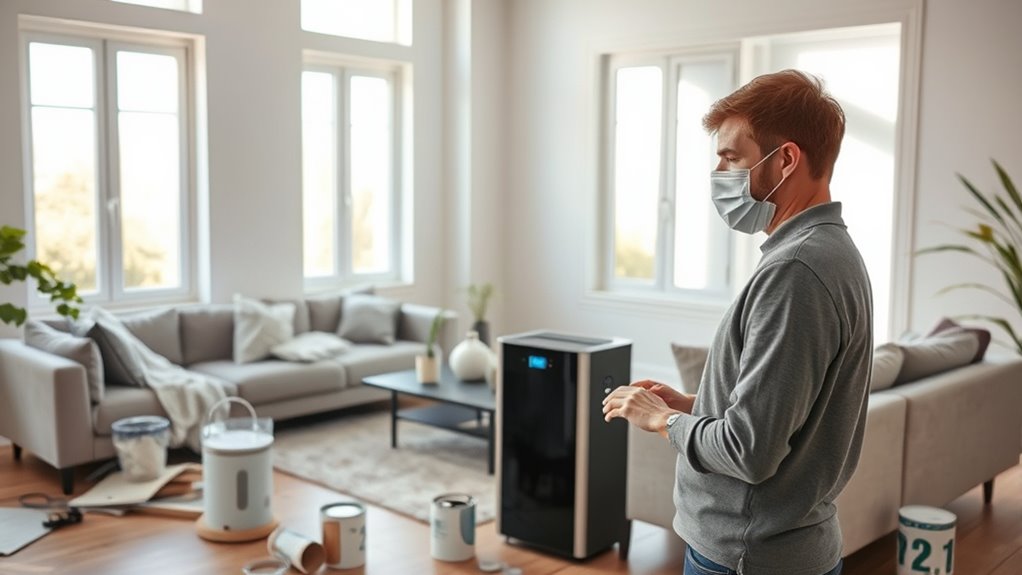
Recent renovations or new furniture can also impact your indoor air quality, especially if proper precautions aren’t taken. New materials often emit volatile organic compounds (VOCs), which can cause headaches, dizziness, or respiratory issues. To protect yourself, focus on air filtration and VOC reduction strategies. You might notice:
New furniture and renovations can release VOCs, affecting air quality and health.
- Persistent fumes that won’t dissipate
- Increased allergy or asthma symptoms
- A lingering chemical smell
These signs suggest your indoor air may be compromised. Without proper ventilation or air filtration, VOCs can build up quickly. Consider professional assessment or air purification systems to improve air quality. Addressing these issues promptly helps ensure your home remains a safe, healthy environment after renovations or new furniture installation.
Frequently Asked Questions
How Often Should I Have My Indoor Air Quality Professionally Tested?
You should test your indoor air quality regularly to guarantee a healthy environment. Using air quality monitors can help you track changes, but professional testing is recommended at least once a year or when you notice issues like odors or allergies worsening. Testing frequency depends on your home’s conditions, such as new renovations or allergens. If problems persist, seek professional help to get accurate readings and improve your indoor air quality effectively.
What Are the Risks of Ignoring Indoor Air Quality Problems?
Ignoring indoor air quality issues is like leaving a silent storm to grow inside your home. You risk health hazards like allergies, asthma, and respiratory infections, which can worsen over time. The long-term effects could seriously impact your well-being, causing chronic health problems. Addressing these issues early helps prevent dangerous build-up of pollutants, safeguarding your health and creating a safer, more comfortable living environment for you and your family.
Can DIY Solutions Effectively Improve Indoor Air Quality?
DIY remedies can help improve indoor air quality temporarily, but they often fall short of ensuring air purifier effectiveness over time. While simple solutions like frequent cleaning and ventilation can reduce pollutants, they might not address all issues. If air quality problems persist despite your efforts, it’s best to seek professional help to identify underlying causes and implement more effective, long-term solutions.
How Do I Choose a Qualified Indoor Air Quality Specialist?
When choosing an indoor air quality specialist, you should look for someone with solid industry experience and proper certification standards. Verify their credentials and ask about their training and certifications like IAQ or HVAC certifications. A qualified professional will assess your home thoroughly, identify issues accurately, and recommend effective solutions. Don’t settle for someone without proven expertise—your health depends on choosing a knowledgeable, certified expert who understands indoor air quality best practices.
What Are the Costs Associated With Professional Indoor Air Quality Assessment?
You should expect assessment costs and service fees to vary depending on the size of your space and the complexity of the issue. Generally, professional indoor air quality assessments range from $200 to $600. Some specialists charge per hour, around $100 to $200. Keep in mind, investing in a thorough assessment can help identify problems early and save you money on future repairs or health-related issues.
Conclusion
If those strange smells linger, or you notice your allergies worsening despite cleaning, it’s time to act. Picture hidden mold spreading behind walls or unseen pests lurking in shadows—dangerous threats hiding in plain sight. Don’t wait until your indoor air becomes a silent enemy. Seek professional help now, and breathe easier knowing you’re uncovering the unseen risks before they take hold. Your health depends on what you can’t see—so take action today.
